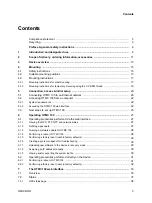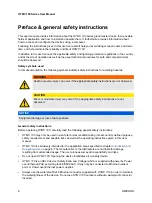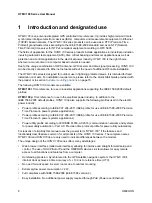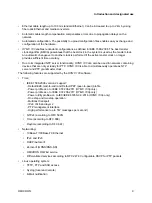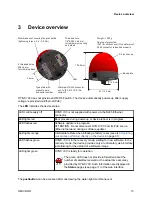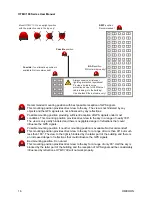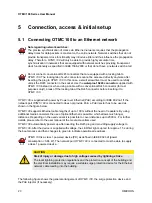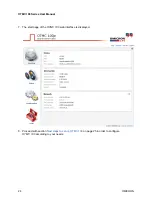
•
Ethernet cable length up to 100 m (standard Ethernet). Can be increased to up to 2 km by using
fiber optic Ethernet and media converters.
•
Automatic cable length compensation compensates errors due to propagation delays on the
network.
•
Automated configuration. The possibility to upload configuration files enables easy exchange and
configuration of the hardware.
•
OTMC 100
enables redundant configurations as defined in IEEE 1588-2008. The best master
clock algorithm (BMCA) guarantees that the best clock in the system is used as the master clock.
An automatic changeover to another clock is performed if the active master clock no longer
provides sufficient time accuracy.
•
Due to its integrated NTP server functionality,
OTMC 100
can also be used in networks containing
devices that are not yet ready for PTP.
OTMC 100
is able to simultaneously operate as NTP
server and PTP grandmaster clock.
The following features are supported by the
OTMC 100
software:
•
Time:
•
IEEE 1588-2008 version 2 support:
- Default E2E (end-to-end) and Default P2P (peer-to-peer) profile
- Power profile acc. to IEEE C37.238-2011 (
OTMC 100p
only)
- Power profile acc. to IEEE C37.238-2017 (
OTMC 100p
only)
- Power utility profile acc. to IEC/IEEE 61850-9-3:2016 (
OTMC 100p
only)
- One step and two step operation
- Multicast transport
- IPv4, IPv6 and layer 2
- PTP management interface
- High performance (up to 512 messages per second)
•
NTPv4 (according to RFC 5905)
•
Time (according to RFC 868)
•
Daytime (according to RFC 867)
•
Networking:
•
10Base-T/100Base-TX Ethernet
•
IPv4 and IPv6
•
DHCP/Autoconf
•
Zeroconf (mDNS/DNS-SD)
•
OMICRON OMFind service
•
Differentiated services according to RFC 2474: Configurable DSCP for PTP packets
•
Linux operating system:
•
TFTP, FTP and SSH access
•
Syslog (local and remote)
•
E-Mail notification
Introduction and designated use
OMICRON
9



